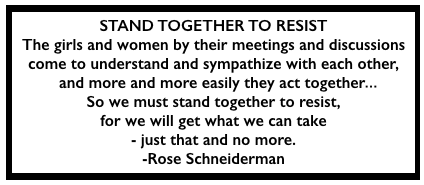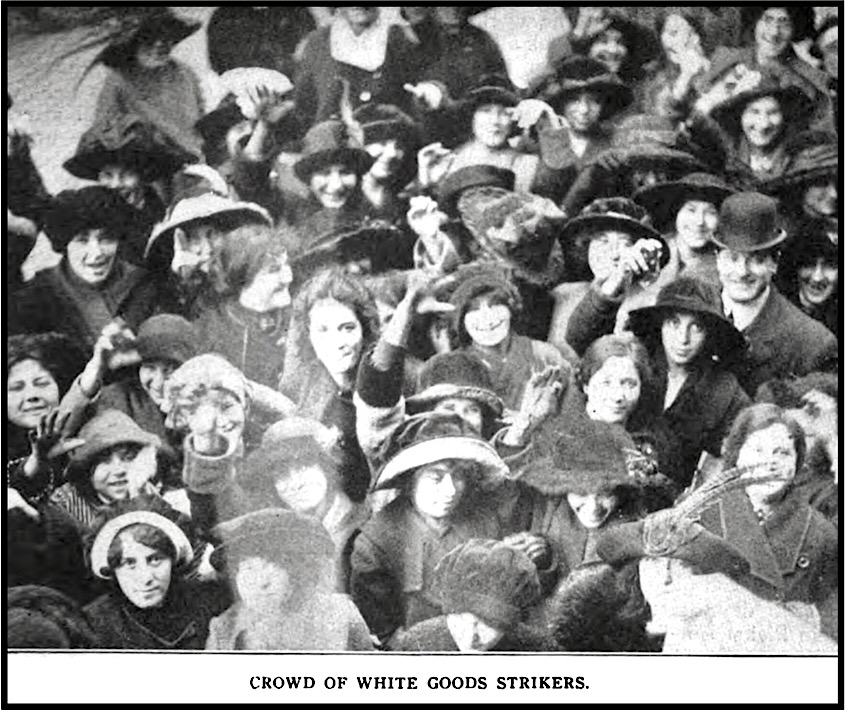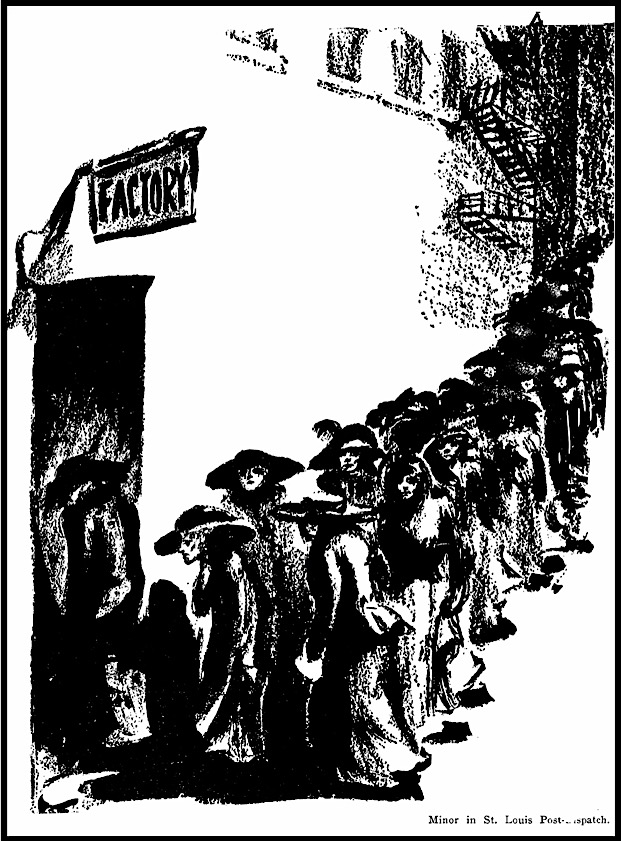 —————
—————
Hellraisers Journal – Tuesday February 4, 1913
New York, New York – The Garment Strike by Mary Marcy, Photos by Paul Thompson
From the International Socialist Review of February 1913:
THE NEW YORK GARMENT WORKERS
By MARY E. MARCYPhotographs by Paul Thompson, New York.
[Part II of III]
The thugs employed by the shop bosses have proved very energetic and reliable. They have worked early and late beating up strikers whenever possible, starting trouble and blaming it on the workers, while the police stood by (or took a hand) to see that nobody attacked or injured them.
During the first week in January the union officials conferred with the employers relative to a settlement of the strike, but the New York Call reports that all negotiations were broken off when the employers insisted upon a return of the strikers to the shops pending an investigation of the conditions in the trade by a special commission to be appointed for that purpose. The union officials declared that under no circumstances would “they order the men to return to work” pending an investigation or arbitration of their demands.
As the pickets began to suffer at the hands of the company guards, it was decided to take a lesson from the strikers at Lawrence, Mass., and chain picketing was employed for the first time in New York City.
Ten thousand pickets were asked to report each day, starting to work on the “Chain Picket Line” at 5 :00 o’clock in the morning, to pass constantly in a steady stream of pedestrians before the strikebound shops.
On the day of the inauguration of the Chain Picket plan, the unions held various meetings which were well attended by the strikers. Hugh Frayne urged a general strike in every branch of the needle and garment industries, promising the support of the A. F. of L. while Abe Cahan closed one meeting begging the strikers to be true to the American Federation of Labor. He urged them to carry an A. F. of L. card in one pocket and a Socialist party card in the other (that is to work for class organization on one side and craft division on the other.)
This is very different from the calls of the Industrialists, all of whom insist upon a CLASS UNION card on the industrial field and a Socialist party card to represent their class interests upon the political field.
The Socialists have rallied around the striking garment workers to help them in this fight in many ways. We hope they will not neglect the greatest opportunity of their lives to teach class unionism as well as class political action. In the hope of a strike victory we should point out that strikes are only a part of the great class struggle and that if the workers would only unite in one great working class union and one great proletarian Socialist party they could forever banish exploitation and the wages system.
It is reported by Gertrude Barnum, one of the publicity agents of the International Ladies’ Garment Workers’ Union, that some of the bosses in the wrapper and kimona industry are anxious to see the trade organized, as they believe the industry would become better systematized. They claim that they find it hard to deal with the workers individually.
Is it possible that the employers of labor find it easier to deal directly with labor union officials than the workers individually? There is something a great deal more than suspicious in such a statement. If the employers desire to have their factories or shops organized in order that they may treat with union officials over questions of wages and hours of labor, it is very doubtful if such unionism can be of any possible benefit to the workers. It is obvious that if a union brings greater profits to the bosses it cannot at the same time give the workers a greater portion of the value of their own products.
But if the statements of Miss Barnum are true, it must be confessed that the employers are showing themselves a great deal more class conscious than she is, for they are employing scabs as fast as they can secure them, and their army of thugs and “guards” is daily on the increase. They very evidently understand that they cannot give higher wages or shorter hours to their wage slaves without cutting down dividends.
We hope the industrial unionists, both inside and outside of the party, are on the job in New York now, and showing up the class character of society so that the workers on strike today may hear, at least once in their lives, a class union talk, a revolutionary appeal. The rank and file of the striking garment workers are all right. The actual workers in the industries are always of open mind for the right kind of propaganda. Not one quarter of the garment workers are in any labor organization. Now is the time to talk One Big Union to them.
The Strike Committee of the S. P. of Local New York, is calling for funds and food to aid the strikers.
Late reports coming in show that in some cases the bosses are making heroic efforts to keep the girls in the white goods industry from joining the strikers. It was reported that organizers going to The Randall Underwear company found the doors locked and girls protesting against their incarceration. When the doors were finally opened, 100 girls left and joined the strike.
[Emphasis added.]
~~~~~~~~~~~~~~~~~~~~~~~~~
SOURCES & IMAGES
Rose Schneiderman Quote, Stand Together to Resist Mar 20, NY
Independent p938, Apr 1905
https://babel.hathitrust.org/cgi/pt?id=coo.31924106546991&view=2up&seq=960
International Socialist Review
(Chicago, Illinois)
-Feb 1913, -article begins on page 583
https://www.marxists.org/history/usa/pubs/isr/v13n08-feb-1913-ISR-gog-ocr.pdf
See also:
Hellraisers Journal: From the International Socialist Review:
“The New York Garment Workers” by Mary E. Marcy
Part I
Nov 16, 1912, St Louis Post Dispatch
-“Why Women Want to Vote” by Robert Minor
https://www.newspapers.com/clip/118010800/nov-16-1912-st-louis-post/
Examples of Cartoons by Robert Minor, 1908-1921
https://www.marxists.org/subject/art/visual_arts/satire/minor/index.htm
Robert Minor (1884–1952)
http://www.laborarts.org/exhibits/themasses/bios.cfm%3Fbio=robert-minor.html
Tag: Robert Minor
https://weneverforget.org/tag/robert-minor/
Tag: New York Garment Workers Strike of 1913
https://weneverforget.org/tag/new-york-garment-workers-strike-of-1913/
~~~~~~~~~~~~~~~~~~~~~~~~~
Working Girl Blues – Hazel Dickens & Alice Gerrard


